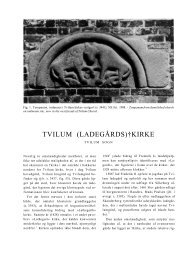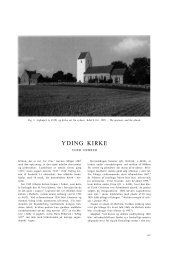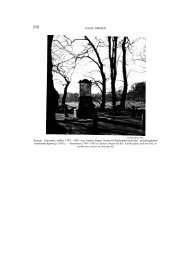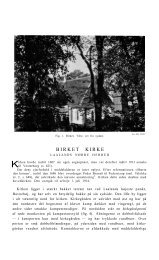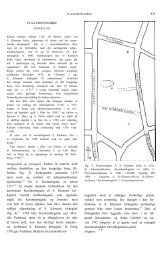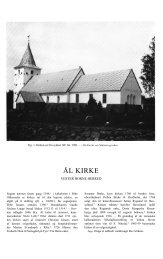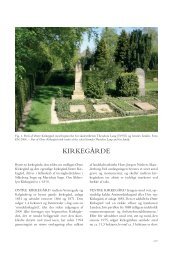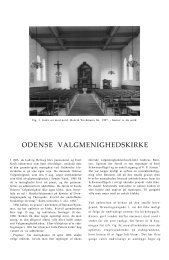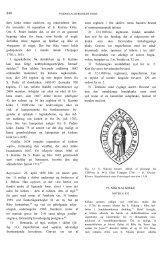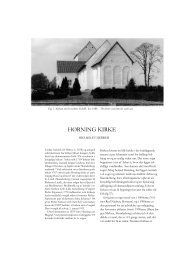Create successful ePaper yourself
Turn your PDF publications into a flip-book with our unique Google optimized e-Paper software.
5170<br />
of this dramatic event was later told repeatedly<br />
in varied forms by chroniclers in Denmark and<br />
abroad. Closest to the scene shown on the Tamdrup<br />
panels, where the ordeal can be seen to take<br />
the form of wearing a redhot glove (figs. 68, 89),<br />
are the versions in Saxo Grammaticus’ Gesta Danorum<br />
and a later addition to Adam of Bremen’s<br />
history (c. 1075) – both accounts, like the panels,<br />
from c. 1200. By contrast, no preserved sources<br />
are known for the continuation of the story on<br />
the Tamdrup panels, where we apparently see the<br />
Danish King showing the church his humble allegiance<br />
and donating the rich gifts (figs. 9294).<br />
That Poppo’s ordeal, according to the Tamdrup<br />
panels, won him both a bishopric and sainthood<br />
is evident from his bishop’s robes and halo. However,<br />
the role of the King is also so prominent<br />
that it looks like an attempt to give Harald Bluetooth<br />
or his son Sweyn Forkbeard (†1013) the<br />
status of a kind of Danish Constantine in the<br />
mythology of the Danish monarchy. The reason<br />
Sweyn Forkbeard has also been proposed as the<br />
King on the Tamdrup panels is that the Poppo<br />
story, in the Danish historiography of the High<br />
Middle Ages – for example in Saxo , was often<br />
transferred from King Harald to him.<br />
The representation of the story of the otherwise<br />
unknown ‘St. Poppo’ in Tamdrup seems to suggest<br />
as a background a special local cult with pilgrimages,<br />
which might help to explain the large, rich<br />
building, and in fact implies that, locally at least,<br />
Tamdrup was singled out as the locus of the triumph<br />
of Christianity in Denmark. And the ‘national’<br />
character and implications of such a cult<br />
must be a crucial argument in favour of a Royal<br />
foundation and continued patronage. We may<br />
compare this to William the Conqueror’s Battle<br />
Abbey, founded on the battlefield at Hastings,<br />
where he had won the crown of England in 1066,<br />
or to Valdemar the Great’s foundation of Vitskøl<br />
Abbey out of gratitude for the victory on Grathe<br />
Heath in 1157, when he won the monarchy of<br />
Denmark for himself and his line.<br />
The erection of the present church building in<br />
Tamdrup may very well have been the work of<br />
King Niels (110334). And the idea of Royal patronage<br />
is presumably supported by the founder’s<br />
ENGLISH SUMMARY<br />
pictures on the golden altar from c. 1200, since<br />
here, in the most prestigious place on the right<br />
of the Christ in Majesty, we see a crowned woman<br />
– probably a queen, or perhaps a duchess<br />
(fig. 101a). She could be Valdemar the Great’s<br />
widow, Sophia of Novgorod (†1198). But perhaps<br />
we should seek a more likely foundress in<br />
the branches of the Royal family that were dethroned<br />
after 1157 – and possibly among the descendants<br />
of King Niels.<br />
The association with a losing branch in the<br />
struggles for the throne in the 1100s would at<br />
least offer one explanation of why no monastery<br />
was ever attached to the church. And it would<br />
make it easier to understand why in the Late<br />
Middle Ages the place appears to have become<br />
a shrine of primarily local significance, although<br />
probably with some pilgrimage.<br />
Reasonably consistent as these arguments seem,<br />
it must be emphasized that they are based more<br />
or less exclusively on the presumed implications<br />
of the building itself and it ornamentation. The<br />
written evidence of Poppo’s ordeal locates it variously<br />
in Schleswig, in Ribe, on the island of<br />
Mors (North Jutland) and at the Isøre Thing<br />
(Zealand), while Tamdrup is not mentioned at<br />
all. The sources are equally silent about any pilgrimage<br />
to Tamdrup, in the Late as in the Early<br />
Middle Ages. The place thus still presents a fascinating<br />
mystery.<br />
THE CHURCH BUILDING. The church,<br />
which has preoccupied art historians since 1870,<br />
is a large, very well preserved calcareous tufa<br />
building, with a dendrochronological dating to c.<br />
1125. It takes the form of a basilica with a chancel<br />
and a threeaisled nave, originally with apses<br />
at the eastern end (fig. 18). To this Romanesque<br />
complex a porch was added in the north and a<br />
large tower in the west in the Late Middle Ages;<br />
the nave was rebuilt and furnished with vaulting<br />
and the chancel was extended with a sacristy in<br />
the east (fig. 17).<br />
The church very likely had a predecessor of<br />
wood, since the archaeological excavations in 2001<br />
were able to establish that there had been burials at<br />
the site before the building of the stone church.




